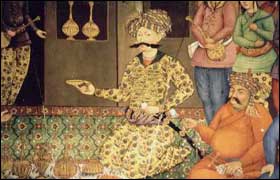| Revision as of 14:17, 19 August 2003 editPascal (talk | contribs)Extended confirmed users720 editsmNo edit summary← Previous edit | Revision as of 14:18, 19 August 2003 edit undoPascal (talk | contribs)Extended confirmed users720 editsmNo edit summaryNext edit → | ||
| Line 3: | Line 3: | ||
| <div style="float:right;margin:0 0 1em 1em;">]</div> | <div style="float:right;margin:0 0 1em 1em;">]</div> | ||
| In ] he became shah, by revolting against his father, ]. Because of the weakness of his army, he made an unfavorable peace with the ] in 1590 and chose ] in 1598 as his capital. A year later, the ] Sir Robert Sherley directed a major army reform. With his new army, the Uzbeks (]) and the Turks (]) were defeated, forcing them to give back the territory they had seized, including Baghdad. He also expelled the ] traders who had seized the island of ] in the Persian Gulf. Shah Abbas' reign, with its military successes, efficient administrative system, raised Iran to the status of a great power. Abbas was a great diplomat, tolerable to his Christian subjects in ] and sending Sherley to Italy, Spain and England in order to create a pact against the Turkish. | In ] he became shah, by revolting against his father, ]. Because of the weakness of his army, he made an unfavorable peace with the ] in 1590 and chose ] in 1598 as his capital. A year later, the ] Sir Robert Sherley directed a major army reform. With his new army, the Uzbeks (]) and the Turks (]) were defeated, forcing them to give back the territory they had seized, including Baghdad. He also expelled the ] traders who had seized the island of ] in the Persian Gulf. Shah Abbas' reign, with its military successes, efficient administrative system, raised Iran to the status of a great power. Abbas was a great diplomat, tolerable to his Christian subjects in ] and sending Sherley to Italy, Spain and England in order to create a pact against the Turkish. | ||
| Trade with the west and industry grew. Esfahan became the center of Safavid architectural achievement, with the mosques Masjid i Shah and the Masjid i Sheykh Lotfollah; and other monuments like the Ali Qapu, the Chehel Sotoun, and the Meydan-i Shah. | Trade with the west and industry grew. Esfahan became the center of Safavid architectural achievement, with the mosques Masjid i Shah and the Masjid i Sheykh Lotfollah; and other monuments like the Ali Qapu, the Chehel Sotoun, and the Meydan-i Shah. | ||
Revision as of 14:18, 19 August 2003
Abbas I (1557-1629) was a influential Shah of Persia of the Safavid Dynasty.

In 1588 he became shah, by revolting against his father, Mohammad Mioza of Safavid. Because of the weakness of his army, he made an unfavorable peace with the Ottomans in 1590 and chose Esfahan in 1598 as his capital. A year later, the English Sir Robert Sherley directed a major army reform. With his new army, the Uzbeks (1597) and the Turks (1603) were defeated, forcing them to give back the territory they had seized, including Baghdad. He also expelled the Portuguese traders who had seized the island of Hormoz in the Persian Gulf. Shah Abbas' reign, with its military successes, efficient administrative system, raised Iran to the status of a great power. Abbas was a great diplomat, tolerable to his Christian subjects in Armenia and sending Sherley to Italy, Spain and England in order to create a pact against the Turkish.
Trade with the west and industry grew. Esfahan became the center of Safavid architectural achievement, with the mosques Masjid i Shah and the Masjid i Sheykh Lotfollah; and other monuments like the Ali Qapu, the Chehel Sotoun, and the Meydan-i Shah.
Afraid of a coup by his family (like he had done to his father), he locked them up in palaces in order to keep them without knowledge of the outside world. This resulted in weak successors.